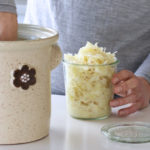Print
Homemade European Sauerkraut with Caraway
RAW | PACKED WITH PROBIOTICS | RICH IN VITAMIN C
⠀⠀⠀⠀⠀⠀⠀⠀
Fermenting your own sauerkraut is one of the most fun cooking projects, and it's surprisingly easy to do. All you need is some basic equipment, and you can get fermenting right away, with the help of salt and friendly, naturally occurring lactobacillus bacteria. So, take a deep breath and give this recipe a try.
⠀⠀⠀⠀⠀⠀⠀⠀
Fermenting your own sauerkraut is one of the most fun cooking projects, and it's surprisingly easy to do. All you need is some basic equipment, and you can get fermenting right away, with the help of salt and friendly, naturally occurring lactobacillus bacteria. So, take a deep breath and give this recipe a try.
Servings 0
Ingredients
- 1 large head green cabbage about 4 pounds; 1.8kg, trimmed, cored, and shredded, outer leaves reserved
- 1 Granny Smith apple—peeled cored and very thinly sliced on a mandoline
- 2 Tbsp Celtic sea salt see NOTES
- 1 Tbsp caraway seeds
- Peel off and discard any wrinkly dry or damaged outer leaves from the cabbage. Reserve one healthy, pliable leaf for later cut the cabbage into quarters right through the core. Carefully cut out and discard the tough inner core. Shred the cabbage. You can use a mandolin, knife or food processor. We prefer using a food processor fitted with the shredding blade.
Instructions
- Put the shredded cabbage into a large bowl. Sprinkle salt and caraway over the cabbage and massage it with your hands until liquid starts to release. Set it aside.
- While the cabbage is marinating, peel and slice the apple. Add the sliced apple to the bowl with the cabbage. Use your hands to work the apple through the cabbage evenly, then once again massage the cabbage until it releases plenty of liquid when squeezed in your hands.
- Transfer the cabbage to a wide mouth quart-sized Mason jar or Fermentation Crock, packing it down tightly with each handful added to the jar. When the cabbage is tightly packed down, take the cabbage leaf you saved earlier and gently fold it until it is about the same width and proportion as the jar. Place the leaf into the jar, on top of the packed cabbage and make sure it covers it completely.
- Press the cabbage leaf down firmly, then pour enough brine from the mixing bowl to cover all of the cabbage and submerge it in the liquid. The cabbage must be below the water (brine) level, away from oxygen. Be sure to leave an inch of space between the top of the liquid and the top of the jar. Doing this allows for expansion. Do not leave too much room at the top of the jar as too much oxygen could cause your kraut to go bad.
- Allow the kraut to ferment in a cool, dark place for at least three days and up to 3 weeks, depending on the desired degree of sourness. Once the kraut has fermented to your liking, seal the jar and transfer it to the refrigerator. Fermenting will continue to take place in the fridge, but this will be very, very slow. Refrigerate in sealed containers for up to 6 months Flavors can change over time.
Notes
The salt choice is significant with fermented foods. You want to avoid processed salts like table salt and iodized salt as they contain additives that can inhibit fermentation. Your best salt choices are those that are fine-grained, dry and mineral-rich, such as, Celtic or pink Himalayan salt.
If you like your sauerkraut quite sour, you might want to allow longer fermentation - anywhere from 3 to 6 weeks, depending on your preference. Throw out the sauerkraut if it becomes discoloured, slimy, or has become mouldy.
If you like your sauerkraut quite sour, you might want to allow longer fermentation - anywhere from 3 to 6 weeks, depending on your preference. Throw out the sauerkraut if it becomes discoloured, slimy, or has become mouldy.
